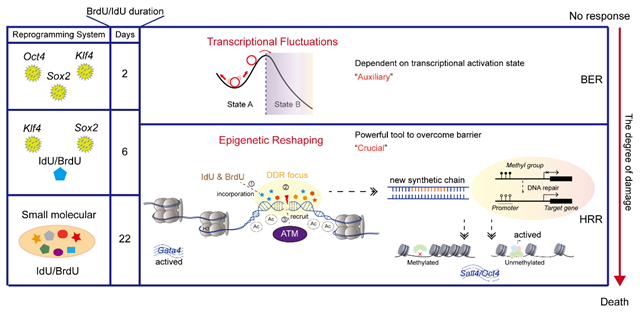Scientists Uncover New mechanisms of BrdU/IdU Induced Epigenetic Reshaping through DNA Damage Repair in Somatic Cell Reprogramming
Recently, the research team led by Prof. LIU Jing at the Guangzhou Institutes of Biomedicine and Health, Chinese Academy of Sciences, published an article titled "Epigenetic reshaping through damage: promoting cell fate transition by BrdU and IdU incorporation"in the journal Cell & Bioscience. The research reveals the molecular mechanisms by which the base analogues BrdU and IdU promote somatic cell reprogramming through DNA damage repair pathways, regulating histone acetylation and DNA demethylation, and establishes the correlation between their dosage and effects across multiple reprogramming systems.
This research is based on the highly efficient chemical reprogramming system with well-defined chemical components previously established by the team. In that system, BrdU plays a crucial role as a base analogue, but its mechanism was not clear. Therefore, this research addresses the key scientific question of how the randomness of base analogues, integrating randomly into the genome, participates in the precise process of somatic cell reprogramming, which is fundamentally an epigenetic reprogramming process, and how it impacts and regulates epigenetic reprogramming.
The research found that BrdU can play a role in two stages of chemical reprogramming and can be substituted by IdU. During the first stage, the transition of somatic cells to an XEN(extraembryonic endoderm)-like intermediate state, continuous treatment with BrdU/IdU causes DNA damage accumulation. Inhibiting the main repair pathway for double-strand breaks, ATM (ataxia telangiectasia-mutated), can significantly reduce the efficiency of chemical reprogramming. The acetylation of key genes in the XEN-like state, such as Gata4, Sox17, and Sall4, is specifically upregulated under base analogue treatment. The activation of ATM leads to a phosphorylation-acetylation cascade, suggesting that base analogues can activate the ATM signaling pathway by inducing DNA damage, leading to the accumulation of acetylation at the damage sites and thus regulating gene expression. In the second stage, during the transition from XEN-like state to pluripotency, DNA methylation is a major limiting factor. The sustained damage caused by base analogues can lead to the demethylation of newly synthesized DNA strands, losing their original methylation modifications.
Finally, after discovering the specific molecular mechanisms of base analogues, the research further validated the universality of this mechanism in factor reprogramming systems and established an efficient somatic cell reprogramming system centered around BrdU with KLF4 and SOX2 (KS). In this system, BrdU can still promote somatic cell reprogramming through the ATM signaling pathway by activating XEN genes. the research also identified the molecular action characteristics of base analogues in different reprogramming systems and summarized the correlation between their dosage and effects.
In summary, the research found that BrdU/IdU can activate the DNA damage repair pathway (HRR), leading to increased histone acetylation and genome-wide DNA demethylation, thereby regulating somatic cell reprogramming. This research reveals the interplay between the genome and epigenetics in somatic cell reprogramming, providing new insights into the mechanisms of cell fate transition.

Brdu and Idu regulate somatic cell reprogramming through DNA damage repair pathways.
(Image by GIBH)
Contacts:
LIU Jing,Ph.D, Principal Investigator;
Guangzhou Institutes of Biomedicine and Health, Chinese Academy of Sciences
Guangzhou, China, 510530
Email:liu_jing@gibh.ac.cn
Attachment Download:
-
Contact
-
Reference
-
Related ArticleChinese Scientists Demonstrated the Mechanism of How Heterochromatin Relaxer Gadd45a Opens Up Mirna During Pluripotency AcquirementNov 15, 2017On October 12 , Xingguo Liu ’ s laboratory at the Guangzhou Institutes of Biomedicine and Health ( GIBH ) .Chinese Academy of Sciences published an article online entitled “ Gadd45a opens up the promoters regions of miR-295 facilitating pluripotency induction ” in Nature publisher journal Cell Death and Disease . Scientists discovered that heterochromatin relaxer Gadd45a relaxes the promoter regions of miR-295 and increases the expression of miR-295 during reprogramming .Gadd45a activates miR-295 by relaxing its promoter regions during reprogramming.Chinese Scientists Reveal A New Mechanism About Exosomes From Plasmodium-infected Hosts Inhibit Tumor AngiogenesisJul 06, 2017A research group led by Prof . CHEN Xiaoping from the Guangzhou Institutes of Biomedicine and Health ( GIBH ) revealed a new mechanism about exosomes from Plasmodium-infected hosts inhibit tumor angiogenesis .Which was newly published in international academic journal Oncogenesis online on June 26th .Schematic of plasma exosomes from plasmodium-infected mice inhibition of angiogenesis through miR ( 16/322 / 497/17 ) to target VEGFR2 . ( Image by CHEN et al . ).Chinese Scientists Reveal Novel Membrane Binding and Cargo Protein Recognition Mechanism For Sorting NexinsJul 18, 2017Research groups led by Dr . LIU Jinsong and Dr . SHU Xiaodong from the Guangzhou Institutes of Biomedicine and Health ( GIBH ) revealed that SNX16 regulates E-cadherin recycling trafficking through a unique mechanism of coordinated membrane and cargo binding .The work was published in Cell Press journal Structure on July 13th .Chinese Academy of Sciences 190 Kaiyuan Avenue , Guangzhou Science Park Guangzhou ( Canton ) 510530 , China E-mail : xu_jinxin @ gibh . ac . cn.Chinese Scientists discovered the rules for organelle remodeling during pluripotency acquirementAug 02, 2017Xingguo Liu ’ s lab at the Guangzhou Institutes of Biomedicine and Health ( GIBH ) published an article online entitled “ BNIP3L-dependent Mitophagy Accounts for Mitochondrial Clearance during Three Factors Induced Somatic Cell Reprogramming ” in Autophagy . Based on somatic cell reprogramming induced by SKO ( Sox2 .Researchers showed that the interorganellar interactions of endosome , autophagosome and mitochondria contribute to the organelle remodeling and functional shift during the generation of . induced pluripotent stem cells ( iPSCs ) .Pig Model of Huntington’s Offers Advantages for Testing TreatmentsMar 30, 2018Using genetic engineering technology , a team of scientists has established a pig model of Huntington ’ s disease ( HD ) , an inherited neurodegenerative disease .The researchers anticipate that the pigs could be a practical way to test treatments for HD , which is caused by a gene encoding a toxic protein that causes brain cells to die .The National Natural Science Foundation of China , and Guangdong Province .